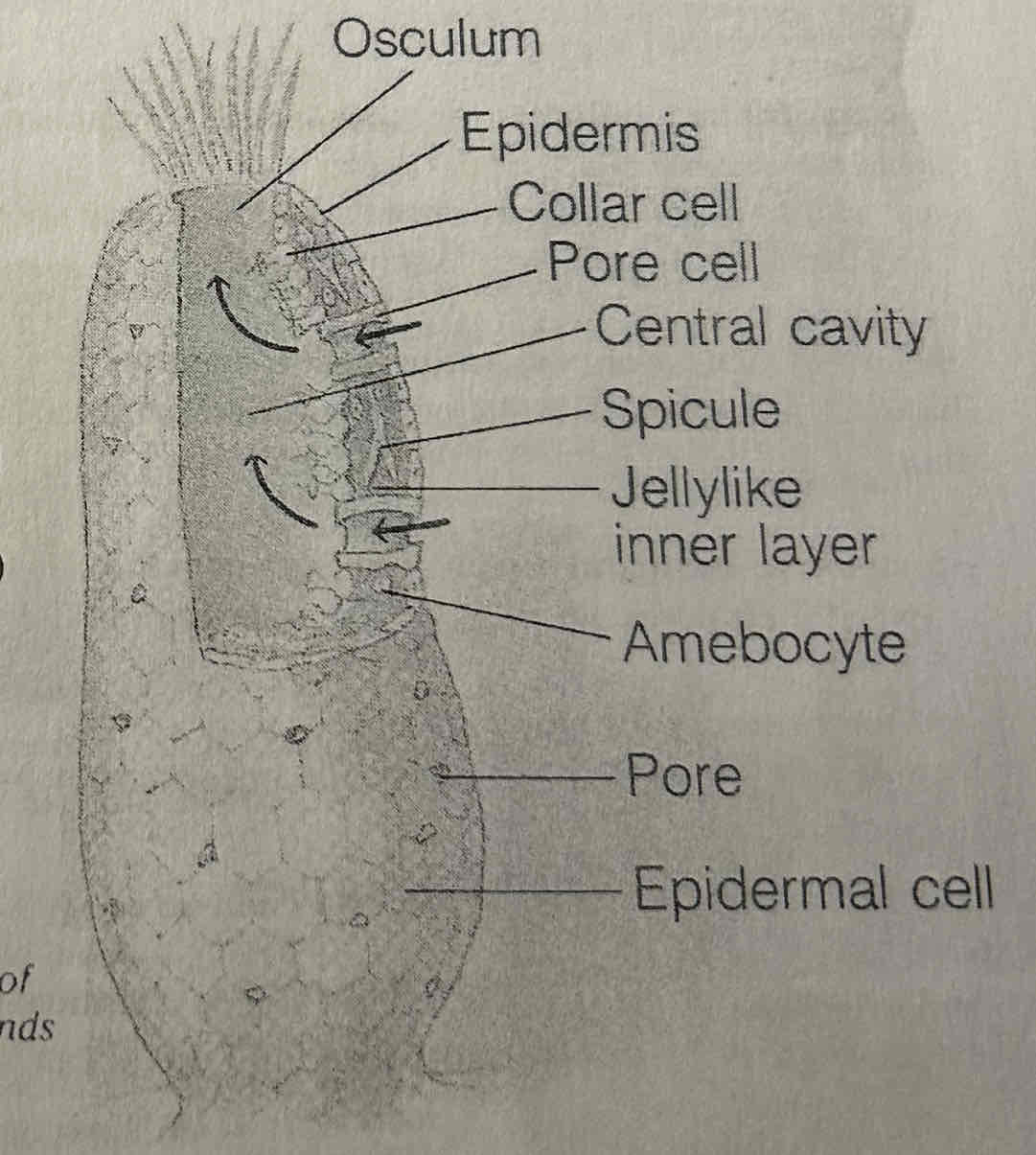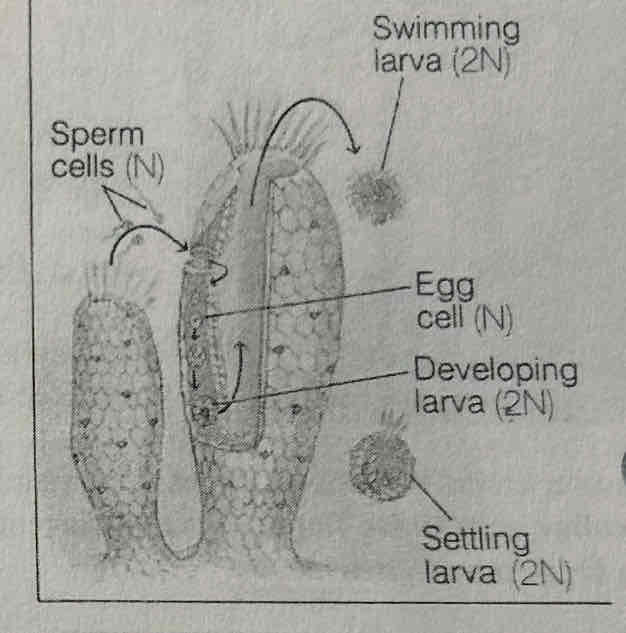26-1 Animal kingdom & 26-2 Sponges
1/15
There's no tags or description
Looks like no tags are added yet.
Name | Mastery | Learn | Test | Matching | Spaced |
|---|
No study sessions yet.
16 Terms
Animal Kingdom (8)
The most diverse kingdom
Animals are: heterotrophs, eukaryotic (have nucleus), multi-cellular, have no cell walls
Animals have 7 basic life functions: feeding, respiration, internal transport, excretion, response, movement, reproduction
2 types of animals:
vertebrates (w/ backbone)
invertebrates (no backbone)
Show "division of labor": have specialized cells that only perform 1 main function
ex: have specialized cells for: feeding, respiration, elimination of waste, etc
Feeding (6 types)
Herbivores
Carnivores
Omnivore
Parasites
Filter feeders (extracting small pieces of food and other particles from the water)
Detritus feeders (feed on decaying plants and animals)
Respiration (2)
Taking in oxygen for each cell
Removing carbon dioxide from each cell during the process of cellular respiration
Internal Transport (2)
The movement of materials to and from different cells in the body
ex: the circulatory system moves materials to and from each cell
Excretion (3)
Occurs during cellular metabolism (the daily activity of a cell)
Chemical wastes that are produced need to be removed from the cells and the body
ex: ammonia (Pee/urine)
Response (3)
Organisms must be able to respond to the environment
To find food, mates, predators, avoid danger etc.
nerve cells → nervous system - sense organs
Movement (4)
Sessile (cannot move) vs Motile (can move)
Muscle cells can work with a skeleton
2 Types of skeletons:
an exoskeleton (outside body)
ex: insect
an endoskeleton (inside body)
ex: human
Reproduction (6)
2 Types: Sexual, Asexual
some organisms can alternate between types
Some are live bearers (live birth) vs produce external eggs
Indirect development: Metamorphosis (organism changes their body as they grow)
ex: caterpillar → butterfly
Direct development: offspring just keeps getting bigger
Animal evolution trend 1 (2)
Organisms get more complicated by increasing the levels of organization:
Ex: cells → tissues → organs → organ systems (ex: circulatory system)
Animal evolution trend 3 (4)
Cephalization
Organisms concentrate their sense organs & nerve cells at the anterior end
Ganglia: small clusters of nerve cells
Brain: large numbers of nerve cells are concentrated in one area
Sponges (Phylum + basic info) (5)
Phylum: Porifera (pore-bearers- have holes)
1st multicellular organism (Cambrian Period: 550 million years ago)
Intertidal (Sometimes underwater depending on the time of the day to permanently under water up to 300m)
Evolutionary Dead End: Evolved from a different single celled ancestor organism compared to all other animals (Have remained unchanged)
Very primitive: Has no: mouth, gut, specialized tissues, organ systems, are sessile
Sponge form & function (6)
Has a single opening hollow cavity (central cavity)
Water containing food particles, enters through pores
Collar cells (have flagella) create current to do this and bring in Oz & other nutrients
Water goes out the osculum (opening) w/ COz, cellular waste products, gametes, larvae
Amebocytes
Moveable cells in the bodies of invertebrates
produce spicules (sponge hard skeleton) of SiOz or CaCOz
produce spongin (soft skeleton) of protein (used as the first bath sponges)

Sponges are filter feeders (6)
Flagellated collar cells filter out microscopic food particles from the water
Cells engulf surround and take inside them by a process called endocytosis:
Where the food is digested amebocytes (specialized cells) take the undigested left over food and distributed to all other cells in the sponge
This type of feeding is called intracellular digestion (nutrients are digested inside the cell)
Respiratory, Excretory, & Internal Transport of sponges is all done by flowing water:
A 10 cm by 1cm sponge can move 22.5L/day of water
Sponge sexual reproduction (5)
Gametes are produced inside the body wall
Sperm are released out the osculum into the water where they enter another sponge.
The amebocyte grabs the sperm and transports it to an egg for fertilization which produces a zygote (2N): the first cell
The zygote grows into a larva (immature animal that looks & acts nothing like the adult) and leaves the osculum
It swims away and grows into a new sponge in a different place

Sponge asexual reproduction (Exact clones - 3 ways) (5)
During poor conditions sponges produce gemmules (a cell that can withstand poor conditions)
It will later grow into a new sponge when environmental conditions are better.
Budding: a new sponge grows out of an adult
Regeneration: re-grows damaged body parts
If you grind up a sponge and pass it through filter paper, the cells will re-clump and form many new sponges
Sponge ecology (11)
Produces many habitats for other organisms: on top, inside or underneath
ex: worms, shrimp, snails, starfish live in or near sponges (often live in dark places such as caves)
Many sponges form a symbiosis (live together with a different species) with photosynthetic bacteria, blue-green bacteria & other plantlike protists
They produce food and O2 for the sponge and use the sponges wastes as food
Sponges = Indicator species: 1st organism to die when the health of ecosystem is poor
Ex: if their pores get plugged due to pollution, they will die due to starvation
Food source for many animals but most are not preyed upon
Protected by the sharp spicules & repulsive toxic chemical compounds
a few snails, starfish, fish do eat them
Act as ocean floor cleaners: Produces chemicals which dissolve dead shells & coral releasing nutrients back into the ocean
Some produce repulsive toxic chemical compounds which act as: antibiotics fungicides anti-viral anti-arthritis